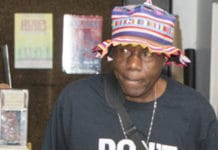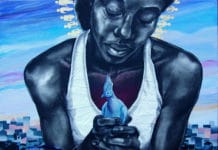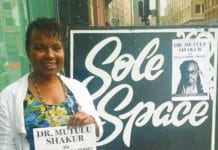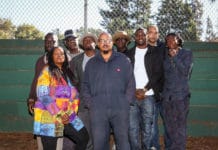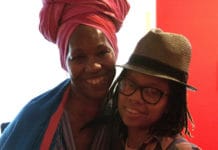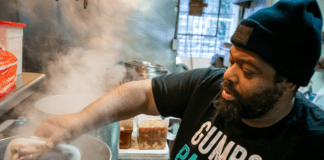Reviews by Wanda Sabir
 When Martin King gave his prophetic speech the evening before the fated march with the sanitation workers in Memphis, Tennessee, Carrie Mae Golden, who lived just around the corner from the Lorraine Motel, wanted to attend, but her mother “was like ‘No. You know they gonna bomb that church. Haven’t you heard the rumors?’” And so 15-year-old Carrie Mae, who had participated in the march just a week before that disintegrated into violence that left 16-year-old Larry Payne dead, the reason King was in town in the first place, missed his speech, something she regretted the rest of her life.
When Martin King gave his prophetic speech the evening before the fated march with the sanitation workers in Memphis, Tennessee, Carrie Mae Golden, who lived just around the corner from the Lorraine Motel, wanted to attend, but her mother “was like ‘No. You know they gonna bomb that church. Haven’t you heard the rumors?’” And so 15-year-old Carrie Mae, who had participated in the march just a week before that disintegrated into violence that left 16-year-old Larry Payne dead, the reason King was in town in the first place, missed his speech, something she regretted the rest of her life.
It is amazing how ghosts, whether ideas or people or events have a way of wafting into existence when the time is right. Carrie Mae Golden’s story becomes the genesis for the award winning play, “The Mountaintop,” which after a successful run on Broadway and London, is back clothed in splendid wonder at TheatreWorks Silicon Valley, March 6-April 7, 2013, after Memphis native, playwright Katori Hall’s work had its initial staged reading at Bay Area Playwrights Festival many years ago.
I remember that Saturday afternoon at the Magic Theatre so well, what a premise to focus on, the space between Martin King’s return to the motel after his speech and the morning march. What was he thinking that night? Was he preparing a speech for the next day? What were his thoughts on the audience that night at the church?
Prophetic, King spoke of the mountaintop and the climb he might not complete, as he dismissed any thoughts that the journey was not without its rewards. Was he alone? If not, who was with him that night?
“The Mountaintop” is not the playwright’s mother’s story. No, even though Carrie Mae’s name is creatively reconstituted as “Camae” (portrayed by actress Simone Missick). Rather “Mountaintop” is a supposition based on the fact that if King visited the mountaintop, then he must have seen certain things which let him know the race was not one he could complete, yet it would be completed because he’d placed such sturdy bricks on the road for others to follow.
 The play opens with King, portrayed by actor Adrian Roberts, craving a cigarette, a Pall Mall to be specific, as he waits for his friend Rev. Ralph Abernathy to bring him a pack from the store. King paces as he rehearses lines in a speech he is drafting for the next day, his throat hurting as he sputters, coughs and wheezes. He calls room service for coffee once he catches his breath, and when it arrives in the hands of the beautiful, spunky maid Camae, it’s over for King literally.
The play opens with King, portrayed by actor Adrian Roberts, craving a cigarette, a Pall Mall to be specific, as he waits for his friend Rev. Ralph Abernathy to bring him a pack from the store. King paces as he rehearses lines in a speech he is drafting for the next day, his throat hurting as he sputters, coughs and wheezes. He calls room service for coffee once he catches his breath, and when it arrives in the hands of the beautiful, spunky maid Camae, it’s over for King literally.
The chemistry is electric and the great leader and orator can’t seem to let the girl go (smile). The attraction is mutual, which is natural. King is a celebrity, yet one whose feet smell; he drinks, smokes her brand of cigarettes, Pall Malls too, and he is, more importantly, attracted to the pretty maid (smile).
One can admire, right?
As the two talk about the riot which brings King to Memphis, the death of the youth, Larry Payne, for whom King feels such regret, what emerges is a man who is afraid, perhaps even terrorized from the stresses he has lived through: bombings, stabbings, imprisonment and the incessant harassment, some of which his wife tells him about when they speak on the phone late that night.
 How does King wade through this trauma? Does Camae ease the journey, and if so, how?
How does King wade through this trauma? Does Camae ease the journey, and if so, how?
What we see in Katori Hall’s Martin King is a man whose faith remains unshaken, his resolve to do God’s will as strong as ever, even when he doesn’t know where that path is headed. In the capable direction of the seasoned veteran director Anthony J. Haney, himself a Southern transplant to Los Angeles, the two actors, Roberts and Missick, work their magic on stage. How does a young maid make this final evening of his life worth all the years of strife? What could the two possibly have to talk about, let alone laugh about as the thunder claps and the rain turns into snow?
Guests are in for a wonderful ride as Hall’s words ripple from the lips and tongues of such a wonderful cast. One just wants to wrap Camae up and take her home, her honesty and youth such a mirror on today: the place where dissatisfaction and impatience often collide when elders and youth meet one another across the aisle. Their goals are often the same, the path, at least the one trod by King, often philosophically at odds. In the Lorraine Motel that night, though, King listens and even agrees at some point with Camae, a Malcolm X radical in an apron.
When asked how she came to her current position, Camae tells King she is good at cleaning up other people’s mess, even if she isn’t as good at cleaning up her own.
 The space that evening is sacred – the cigarettes are frankincense, the balcony just a quicker stairway to heaven, Camae and King two lingering souls looking for a way out of darkness. Hall’s “The Mountaintop” challenges notions of spirituality in all their personae. There are miracles too. The mountain and the valley meet in that room as Camae charts King’s ascension.
The space that evening is sacred – the cigarettes are frankincense, the balcony just a quicker stairway to heaven, Camae and King two lingering souls looking for a way out of darkness. Hall’s “The Mountaintop” challenges notions of spirituality in all their personae. There are miracles too. The mountain and the valley meet in that room as Camae charts King’s ascension.
Katori Hall’s work looks at the everyday divinity of ordinary folks and places Martin King right there with them. His greatness is not a greatness which is inaccessible or isolated, which means those people left here once he reaches the apex of his sojourn can use him as an example and “keep on pushing.”
Camae’s visit to Room 306 seemed predestined. What is it about the congregation of women at a prophet’s door as he opens it onto another? Think about Jesus and the three Marys. In African spiritual systems, an angel or egun or orisha once walked the earth like us, so when one door closes another opens – the sphere a linear cylindrical – we do not step off, we step over. Is this what happens to King his last night here? Is Camae the bridge over King’s troubled waters? Visit www.theatreworks.org or call (650) 463-1960.
The Harvey Milk Photo Center hosts revolutionary artist Emory Douglas
Earlier that day I was in San Francisco for Emory Douglas’s presentation at the Harvey Milk Photo Center, the talk a part of the “Black Power, Flower Power: Iconic photographs by Pickle Jones and Ruth-Marion Baruch” exhibition through March 23, 2013.
It’s too bad the time or the talk conflicted with the screening of “Long Distance Revolutionary” at the New Parkway Theatre in Oakland, that afternoon with director Stephen Vittoria.
 Emory Douglas’ creative visual documentation or interpretation of the period’s best known liberation struggle during the era that gave rise to the Black Power Movement, the Free Speech Movement and the Anti-War Movement is unmatched. Douglas is a treasure and his work then and now both imaginative, inspirational and timely 45 years later.
Emory Douglas’ creative visual documentation or interpretation of the period’s best known liberation struggle during the era that gave rise to the Black Power Movement, the Free Speech Movement and the Anti-War Movement is unmatched. Douglas is a treasure and his work then and now both imaginative, inspirational and timely 45 years later.
As he showed slides of work chronicled in his now out of print treatise: “Black Panther: The Revolutionary Art of Emory Douglas,” edited by Sam Durant (2007), one caught a glimpse of the ever-evolving artist at work, his tools – wax, calligraphy catalog – displayed on the table where one could purchase posters, bags and magnets. His passionate love for the people, which never wavered, was illustrated in a recent piece created for Haitians which addresses the cholera epidemic linked to U.N. soldiers’ contamination of the water supply. Douglas showed us reworked images like the cover image for Sonia Sanchez’s first collection of poetry, a little girl with a spear, and other drawings of comrades still locked behind bars like Romaine “Chip” Fitzgerald and Angola 3 comrades Herman Wallace and Albert Woodfox.
His work looks like block prints, but they aren’t. His portraits minimalist feats where lines parceled out sparingly speak volumes.
Douglas spoke about his time in Beirut and New Zealand. He didn’t talk about Argentina or Portugal much. I think the audience was rather spellbound; so much was covered one didn’t know where to start the query when the floor opened for questions (smile). I wonder, in retrospect, how Douglas came through the revolution seemingly unscathed.
I am sure this is just an illusion, that the loss of friends and comrades has and did take a tremendous toll on him. Perhaps it is his humanity that saved him. One hears often of how Emory visited comrades like the late Geronimo ji jaga here and abroad when after 27 years ji jaga was released and resettled in Tanzania.
Douglas’ energy is so peaceful and calm. I wonder how he achieved this during active warfare and its subsequent aftermath.
Emory Douglas’ creative visual documentation or interpretation of the period’s best known liberation struggle during the era that gave rise to the Black Power Movement, the Free Speech Movement and the Anti-War Movement is unmatched.
The enemy then was not always identifiable, despite the known FBI plan to create disunity and havoc, yet Douglas continued to draw, document and create. I loved his story about the United Farm Workers union march by the Panther headquarters in Berkeley and the BPP invitation to them to join them for lunch afterwards at the Oakland Community School, where people like Rosa Parks spent significant time with the children. The hundreds of marchers did and forged a relationship with the BPP that continued through the grape and strawberry boycotts and other actions. I remember not eating grapes for years in support of the boycott. My kids thought I was insane, but I explained the larger issue to them, that if those picking the crops were dying from the pesticides, then what would those same chemicals do to our bodies.
Emory Douglas showed us a Panther newspaper with his drawing of a head of lettuce and UFW logo on it. The synergy between this historic link and the fact that co-founder of the union with Cesar Chavez, Dolores Huerta, was speaking that same day at perhaps the same time as Emory in the city of Richmond, California’s International Women’s Day event was uncanny (smile). Yet, what people hear about the BPP rarely mentions these types of solidarity building activities.
Amiri Baraka describes “Emory’s art [as] a combination of expressionism agitprop and homeboy familiarity.” He says in an essay, “Emory Douglas: A Good Brother,” a “Bad Artist,” “I always felt that Emory’s work functioned as if you were put in the middle of a rumble and somebody tossed you a machine pistol. It armed your mind and demeanor. Ruthlessly funny, but at the same time functional as the .45 slugs pouring out of that weapon. …
“One of the two artists I most identify with the hottest revolutionary images used in Black Liberation Movement journals, Emory Douglas and the Nation of Islam’s Gerald 2X, with his ubiquitous ‘devil’ in Muhammad Speaks, with fangs hanging out of each side of his George Bush-like mouth, as I said in a poem, ‘used for sucking oil and blood,’ plus the little ‘devil’ tail sticking out of his hiney. Emory together with Gerald 2X were without a doubt the baddest political graphic artists in journalism. As seemingly contradictory as their ideologies were (are), they were the substance of the goodness of a national liberation united front. A double-barreled art gun” (Durant 180-181).
 Emory Douglas didn’t fall into the movement; he chose to be a part of an organization that uplifted his people and fought for political and social justice for the disenfranchised. He had skills which furthered the reach of the organization Huey P. Newton and Bobby Seale founded. Having studied commercial art at City College of San Francisco and in his work with Amiri Baraka and playwrights in the Black House, a place that nurtured a Black literary aesthetic, Douglas who made the sets for the plays, designed fliers and was instrumental in all or most of the visual designs, knew how to make the newspaper look good when he met Newton and Seale, made a proposal, and was subsequently invited to join the party as its “revolutionary artist.”
Emory Douglas didn’t fall into the movement; he chose to be a part of an organization that uplifted his people and fought for political and social justice for the disenfranchised. He had skills which furthered the reach of the organization Huey P. Newton and Bobby Seale founded. Having studied commercial art at City College of San Francisco and in his work with Amiri Baraka and playwrights in the Black House, a place that nurtured a Black literary aesthetic, Douglas who made the sets for the plays, designed fliers and was instrumental in all or most of the visual designs, knew how to make the newspaper look good when he met Newton and Seale, made a proposal, and was subsequently invited to join the party as its “revolutionary artist.”
In the book, “Black Panther: The Revolutionary Art of Emory Douglas,” the artist says in an interview with the late St. Clair Bourne, that he wasn’t looking for fame, that his reward came from “the people.” If they got the message or felt he’d articulated well the situation at hand, that pleased him most.
Last fall I went up to Ashland to catch some of the Oregon Shakespeare Festival, specifically “Party People,” a collaboration between Universes and ASF (http://www.universesonstage.com/). The multimedia jaunt reflects on the Black Panther Party, its successes and some of the internal madness that perhaps did not leak into the rank and file sections. But for those in the inner circles, like Emory Douglas, how did he keep himself from being sucked into a vortex that ground flesh and bones into paste? Is art such a humanizing force that it protects one from succumbing to anything antithetical to life and that which gives life?
I’d like to think so and when I look at the veterans of the Black Liberation Movement leadership like Emory Douglas, Kathleen Cleaver, Elaine Brown, Bobby Seale, Ericka Huggins, Mama Charlotte O’Neal, it seems that what was good continues, the madness left in the past. It would be interesting though to know the specifics of the purification ritual when I think about the youth and their rites and passages – some stuck in alleys and tubes unable to see their way out.
Emory Douglas didn’t fall into the movement; he chose to be a part of an organization that uplifted his people and fought for political and social justice for the disenfranchised.
Movement between historic moments is often traumatic; it would be useful to share survival strategies with the honored guard. How does one survive, let along recover from such systematic oppression? This is just one of the many ideas discussed between Martin King and Camae at the Lorraine Motel one wet, cold night in “The Mountaintop.”
‘The Black Woman Is God’
After I left the Harvey Milk Photo Center, I went over to the African American Art and Culture Complex, where I saw “The Black Women Is God” in the Sargent Johnson Gallery, 762 Fulton St., San Francisco. If the title of the exhibition doesn’t knock your socks off, the actual art, which is both ritual and celebration, will.
Curated by Karen Seneferu and Melorra Green, the exhibition features 21 artists who work in multiple mediums. “The Black Woman Is God” exhibit is up through May 30, 2013. There is a companion exhibit at Gallery 1307 at 1307 Fillmore St., also in San Francisco, open Tuesdays through Saturdays, 12-5 p.m.
Bay View Arts Editor Wanda Sabir can be reached at wsab1@aol.com. Visit her website at www.wandaspicks.com throughout the month for updates to Wanda’s Picks, her blog, photos and Wanda’s Picks Radio. Her shows are streamed live Wednesdays at 6-7 a.m. and Fridays at 8-10 a.m., can be heard by phone at (347) 237-4610 and are archived on the Afrikan Sistahs’ Media Network.

 Store
Store




